On the evevning of 14th February 1945 the crew of this 420 Squadron aircraft took off from Tholthorpe airfield at 17.01hrs to undertake an operational flight to bomb Chemnitz. All appears to have gone well up until the crew were on the return leg of the flight back to Yorkshire. The weather and visibility over this part of Yorkshire was good and the aircraft was seen by members of the Flying Control personnel at Tholthorpe as it made an approach to land, presumably as it was dark they could see the landing and navigation lights. As they neared base the crew stated on the radio equipment that the aircraft was suffering trouble with the port outer engine and that they had stopped the engine and feathered the propeller. What actually appears to have happened is that the port outer engine failed but instead of that engine and propeller being feathered the crew actually feathered the starboard outer engine propeller. While flying roughly at 600 feet the aircraft began a banked turn to starboard probably in trying to line up with the runway, the banking increased and eventually the pilot lost control. The aircraft then dived into ground at 20.08hrs east of Tholthorpe airfield, between Lund Farm and South Carolina Farm and burst into flames. Two civilians who lived in the area were first on the scene and their actions resulted in the mid upper gunner's life being saved. He was seated in the rest position at the time of the crash.
Mr John Stanley Smithson and Mr John Raymond Taylor were both awarded the British Empire Medal for their actions on this night, Gazetted on 19th February 1946 the citation for their award stated that .."An aircraft returning from bombing operations crashed and caught fire in a field. The main bomb load had been dropped but a large amount of ammunition and incendiary bombs carried by the aircraft exploded intermittently. Smithson and Taylor hurried to the scene of the crash and regardless of the intense heat and the danger from the exploding ammunition and bombs rushed into the burning wreckage in response to cries for help. Lying clear of the fuselage itself but amidst the burning debris, they found one member of the crew whom they carried to safety. After giving the injured man first-aid treatment they returned to the wreckage and found and extricated the body of another member of the crew. They then continued to search amongst the wreckage for the rest of the aircrew but were unable to rescue any others. Smithson and Taylor showed courage without thought for their own safety." A map reference located in a basic police record puts the site as being in an area of woodland between the two farms but it probably crashed just outside the woodland because of the reference to a field in the above citation.
Pilot - F/O William Smith Anderson RCAF (J/41164), aged 22, of Toronto, Ontario, Canada. Buried Harrogate Stonefall Cemetery, Yorkshire (H/G/5).
Flight Engineer - Sgt Harry Evans RAFVR (2210219), aged 25, wife of Whiston. Buried Whiston Churchyard, Lancashire.
Navigator - F/O John Charles Sinden RCAF (J/37506), aged 32, of Hornby, Ontario, Canada. Buried Harrogate Stonefall Cemetery, Yorkshire (H/G/8).
Bomb Aimer - F/O Lloyd Ingram Jones RCAF (J/40037), aged 33, of Toronto, Ontario, Canada. Buried Harrogate Stonefall Cemetery, Yorkshire (H/G/7).
Wireless Operator / Air Gunner - F/O Stanley Arthur Hay RCAF (J/39167), aged 32, of Moose Jaw, Saskatchewan, Canada. Buried Harrogate Stonefall Cemetery, Yorkshire (H/G/6).
Air Gunner - P/O Earl Albert Henry Sills RCAF (J/94220), aged 20, of Toronto, Ontario, Canada. Buried Harrogate Stonefall Cemetery, Yorkshire (H/G/4).
Air Gunner - F/Sgt William Herbert Giles RCAF R/276319). Of Toronto, Ontario, Canada. Seriously injured.
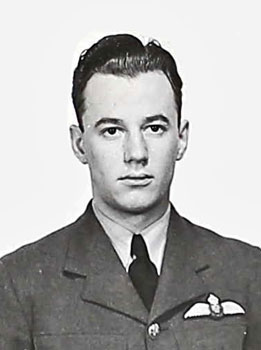

William Anderson was born on 14th September 1922 in Toronto, Ontario, Canada and was the son of Robert Smith and Hazel Margaret (nee Weeks) Anderson. After leaving school in 1940 he studied at a business college before starting work as a clerk at a flour mill. He enlisted for RCAF service on 14th August 1942 in Toronto and after training as a pilot he was awarded his Pilots' Wings and was also granted a commission on 28th January 1944. On arrival in the UK later in 1944 he trained at 18 (P)AFU, 22 OTU and 1666 HCU before posting to 420 Squadron on 28th December 1944.
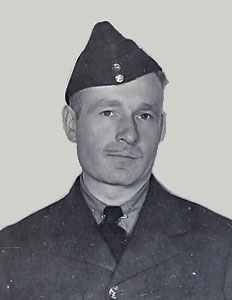
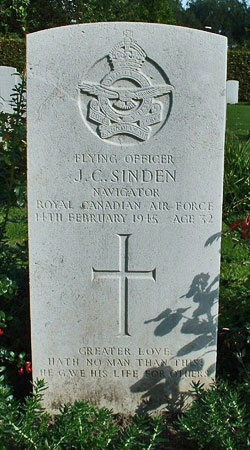
John Sinden was born on 19th May 1912 in Toronto, Ontario, Canada and was the son of Thomas William and Janet Annie (nee Haffenden) Sinden. Both his parents were born in Heathfield, Sussex, England but had emigrated to Canada. He left high school in 1929 and between 1930 and 1942 worked in the offices of Dumarts Ltd, Kitchener, Ontario as a stenographer. He gained a Private Pilots Licence in 1936. Having enlisted for RCAF service on 6th August 1942 he did not enlist to train as a pilot but as a navigator and after training was awarded his navigators' flying badge and also a commission on 29th October 1943. In 1944 he would train at 10 (O)AFU, 22 OTU and 1666 HCU before posting to 420 Squadron with this crew on 28th December 1944.
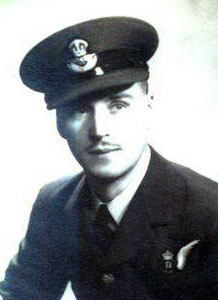
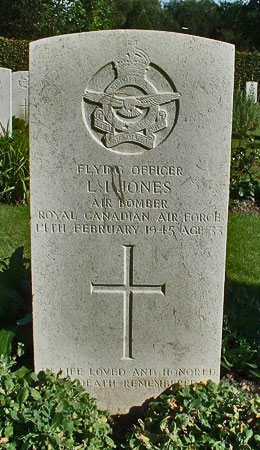
Lloyd Jones was born on 24th August 1911 in Toronto, Ontario, Canada and was the son of Ernest Ephram and Martha Leah (nee Link) Jones. After leaving school he worked for his father's engineering business as a sheet metal worker. He married Lorna Millicent in June 1939 and they had a daughter together. Before the outbreak of WW2 he studied a course in aircraft welding and when he enlisted for RCAF service on 15th May 1940 in Toronto he signed up for ground duties specifically to serve as an airframe mechanic. He served in this role until remustering as aircrew around the end of 1942. After training in Canada he was awarded his air bombers' flying badge and he also received a commission on 23rd December 1943. On arrival in the UK in 1944 he trained at 1 (O)AFU, 22 OTU and 1666 HCU before posting to 420 Squadron on 28th December 1944.

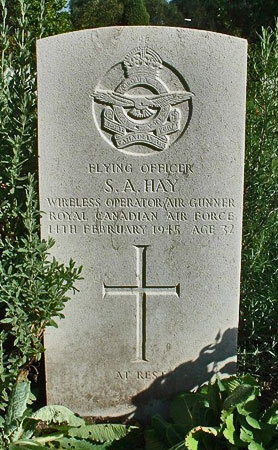
Stanley Hay was born on 6th February 1913 at Caron, Saskatchewan, Canada and was the son of Robert Alexander and Margaret Janes (nee Wilson) Hay. He left school way back in 1928 and worked in farming for nine years in the Rowletta area before becoming a truck driver. He enlisted for RCAF service in Regina on 22nd May 1941 for air crew duties and after training was awarded his air gunners' flying badge on 19th January 1942. He then did wireless operator training and with that training complete he was granted a commission on 31st August 1943. He appears to have arrived in the UK in May 1944.

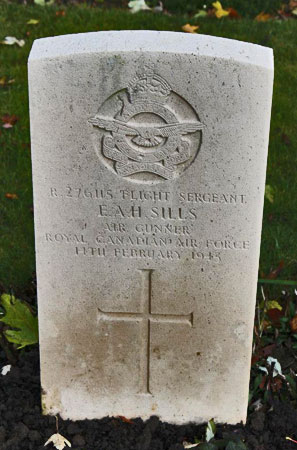
Earl Sills was born on 9th September 1924 in Toronto, Ontario, Canada and was the eldest child of Harry and Ruby Violet (nee Thompson) Sills. He was working for the Canadian Acme Screw and Gear company, possibly with his father, when he enlisted for RCAF service on 8th September 1943 in Toronto. After training in Canada he was awarded his air gunners' flying badge on 24th March 1944. On arrival in the UK in June 1944 he would train at 22 OTU and 1666 HCU before posting to 420 Squadron on 18th December 1944. He appears to have been granted a commission after his death, back dated to 13th February 1945.